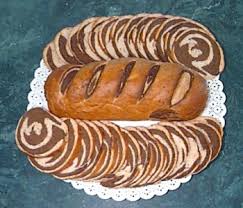Appeared initially in Central Asia, and rye was widespread in northern Europe, including Scandinavia and Germany. Under pressure from the population explosion that took place in the Middle Ages, the cultivation of this cereal then won marginal lands, such as mountainous areas (up to 2000 m). For example, in Switzerland (particularly in the Valais), it manufactures for generations of sourdough rye bread that cowbirds starting to outweigh the pasture in spring for summer use with their alpine cheeses.
Similarly, in France, south west of the Massif Central, the cultivation of rye was developed on the land to poor soil and cold acid called from "Segalas." And if, in Roman times, the rye bread and "black bread" was depreciated against the wheat bread, Germans, accustomed to their sourdough rye bread, then made fun of the French fragile stomachs consuming white bread made from wheat.
In connection with a widespread consumption of rye, it is interesting to note that between the seventh and nineteenth century, periods of witchcraft have generally coincided with epidemics of ergot-ism. Indeed, the grains of rye can be infected by a fungus, "the catch", which causes necrosis of the extremities, as well as hallucinations or other aberrant behavior. Formerly known as "fire of St. Anthony" or "burning sickness" of these illnesses to ergot have sometimes been accused of witchcraft who were affected ...
Since World War II, consumption of rye fell sharply in the world. In recent years, with a surge of environmental awareness, however, this cereal is to the fore. It is mainly in the form of bread that is consumed. In Germany, the "Pumpernickel" black bread whole rye is traditional as well as "knackebrod" in Sweden, crispbread products with grains of crushed rye. From grain, Americans still make the Whiskey and Vodka from Russia. Rye
One can even get an ersatz coffee roasting grains of rye. In addition, these grains can be eaten whole like rice or flaked to enter the composition of a granola. That said, cooking the grains of rye request two hours of time and, because of the taste of this cereal, it is better to eat mixed with wheat or other grain.
This cereal is still used to feed animals, especially cattle and hogs, provided that the grain is cleaned and contains less than 1% ergot. Finally, rye straw, which is very good, is widely used for making thatched roofs, make chairs straw, stuffing or even make mats.
From the nutritional point of view, like rye to wheat. It indeed has a high nutritional value and a wealth of valuable minerals, especially manganese, selenium, magnesium, phosphorus, iron and copper. It also contains valuable vitamins from group B, vitamin E and folic acid. In addition, its high fiber content makes it an interesting food to lower cholesterol, combat and prevent constipation and colon cancer.
Finally, rye is an herb sought in organic farming because it secretes toxic substances prevent weed growth especially in horticulture. It is thus seen as a cleaning plant.

Similarly, in France, south west of the Massif Central, the cultivation of rye was developed on the land to poor soil and cold acid called from "Segalas." And if, in Roman times, the rye bread and "black bread" was depreciated against the wheat bread, Germans, accustomed to their sourdough rye bread, then made fun of the French fragile stomachs consuming white bread made from wheat.
In connection with a widespread consumption of rye, it is interesting to note that between the seventh and nineteenth century, periods of witchcraft have generally coincided with epidemics of ergot-ism. Indeed, the grains of rye can be infected by a fungus, "the catch", which causes necrosis of the extremities, as well as hallucinations or other aberrant behavior. Formerly known as "fire of St. Anthony" or "burning sickness" of these illnesses to ergot have sometimes been accused of witchcraft who were affected ...
Since World War II, consumption of rye fell sharply in the world. In recent years, with a surge of environmental awareness, however, this cereal is to the fore. It is mainly in the form of bread that is consumed. In Germany, the "Pumpernickel" black bread whole rye is traditional as well as "knackebrod" in Sweden, crispbread products with grains of crushed rye. From grain, Americans still make the Whiskey and Vodka from Russia. Rye
One can even get an ersatz coffee roasting grains of rye. In addition, these grains can be eaten whole like rice or flaked to enter the composition of a granola. That said, cooking the grains of rye request two hours of time and, because of the taste of this cereal, it is better to eat mixed with wheat or other grain.
This cereal is still used to feed animals, especially cattle and hogs, provided that the grain is cleaned and contains less than 1% ergot. Finally, rye straw, which is very good, is widely used for making thatched roofs, make chairs straw, stuffing or even make mats.
From the nutritional point of view, like rye to wheat. It indeed has a high nutritional value and a wealth of valuable minerals, especially manganese, selenium, magnesium, phosphorus, iron and copper. It also contains valuable vitamins from group B, vitamin E and folic acid. In addition, its high fiber content makes it an interesting food to lower cholesterol, combat and prevent constipation and colon cancer.
Finally, rye is an herb sought in organic farming because it secretes toxic substances prevent weed growth especially in horticulture. It is thus seen as a cleaning plant.
No comments:
Post a Comment